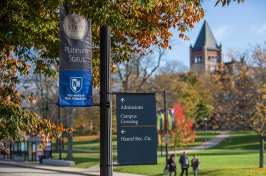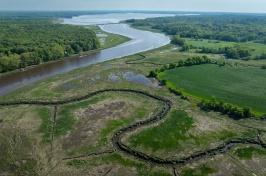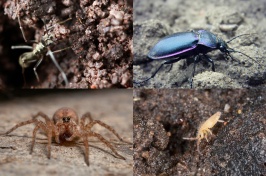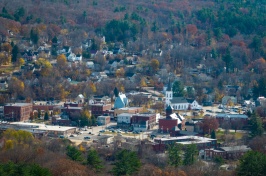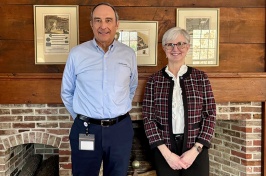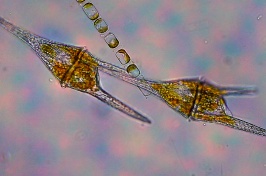The University of New Hampshire is a flagship research university that inspires innovation and transforms lives in our state, nation and world. More than 16,000 students from all 50 states and 71 countries engage with an award-winning faculty in top ranked programs in business, engineering, law, health and human services, liberal arts and the sciences across more than 200 programs of study. UNH’s research portfolio includes partnerships with NASA, NOAA, NSF and NIH, receiving more than $100 million in competitive external funding every year to further explore and define the frontiers of land, sea and space.
UNH Research Finds New England Streams Impacted by High Salt Concentrations

The Merrimack River. Credit: Army Corps of Engineers, New England District
DURHAM, N.H. – University of New Hampshire researchers estimate that more than 10 percent of streams in the Merrimack River watershed, which covers areas of New Hampshire and Massachusetts, are impacted by high chloride concentrations as a result of road salt applied during winter. Salt concentrations can be highest in the summer, raising concerns about harm to freshwater plants, invertebrates, amphibians, and fish.
“People place road salt, which consists mostly of sodium chloride -- table salt -- on our roads, sidewalks, and driveways to improve driving and walking conditions throughout the winter,” said Shan Zuidema, a research scientist with the Water Systems Analysis Group at the UNH Earth Systems Research Center. “Salt dissolves very easily and much of it enters groundwater, then slowly drains into rivers, which dominates flow during summer. The salt content of streams is often highest in summer, not winter.”
“Too much salt can harm a variety of freshwater organisms and many of the plants and animals that form the base of the food web that support fish are affected. We need as much good information as we can to make informed decisions about how to trade off winter safety with preservation of our riverine habitats,” said Zuidema, lead author of the study who conducted the research with colleagues from UNH, Plymouth State University, and the U.S. Forest Service.
Specifically, the researchers investigated how road salt application in winters is impacting stream water quality throughout the year. They were interested in how winter severity and summer weather patterns affect water quality, and hypothesized that summer weather is as important to water quality as winter weather.
“During severe winters we need to use more road salt, so the possible influence of winter weather on stream water quality is obvious. However, since so much of this road salt enters soil, then groundwater, and during dry summers the only source of water in the river is from old groundwater, we expected that the dryness of the summer could explain a lot of the impairment that we observed in New Hampshire streams,” Zuidema said.
Because scientists didn’t have long-term records for streams ranging from small creeks to large rivers, they developed a computer simulation model that calculated how much road salt must have been applied to result in the chloride concentrations that they saw in streams. The model could then simulate conditions in all streams and rivers in the entire watershed.
They found that, on average, about 11 percent of streams in the Merrimack River watershed are impacted by high salt concentrations. They also found that the proportion of all streams that are impacted changes from year to year based on any given year's weather. Unsurprisingly, they found that the amount of winter precipitation indicates how impacted smaller streams will be since greater winter precipitation can mean more road salt is applied. However, they found that summer chloride concentration is driven by the dryness of the summer, but only in larger rivers, particularly in cleaner, less developed part of the watershed just downstream of the White Mountains.
“We were quite surprised to see how different the effect of high snow years was on large versus small rivers. Our results suggest that if high snow years are associated with wetter summers, large rivers have better water quality because cleaner parts of the watershed like the White Mountains dilute the poorer water quality coming from more polluted streams. The response of the model and in the data makes sense because so much of the water leaving the Merrimack River watershed is from the mountains,” said New Hampshire Agricultural Experiment Station researcher Wilfred Wollheim, associate professor in the department of natural resources and the environment and one of the study’s authors.
“However, we didn’t anticipate that effect would overwhelm the additional loading from road salt. It would be interesting to see what kind of response would emerge from applying the model to different watersheds with different configurations of land use,” Wollheim said.
Going forward, UNH scientists plan to expand the model to additional New England watersheds that have similar threats from road salt. The model also allows them to look at questions of change over time -- how land use change and climate change may alter water quality impairment due to salt contamination. Most importantly, on-going applications of the model will apply different road salt application rates to see how river conditions change.
This study was funded by the NH EPSCoR Ecosystems & Society Project provided by the National Science Foundation's Research Infrastructure Improvement Award #EPS 1101245. Additional support was provided by the NH Agricultural Experiment Station, through joint funding of the National Institute of Food and Agriculture, U.S. Department of Agriculture, under award number 1013433, and the state of New Hampshire. Support also was provided by the National Science Foundation’s Plum Island Ecosystems LTER (#OCE 1637630).
PHOTOS AVAILABLE FOR DOWNLOAD:
https://colsa.unh.edu/nhaes/sites/default/files/media/images/merrimack_river.jpg
The Merrimack River. Credit: Army Corps of Engineers, New England District
https://colsa.unh.edu/nhaes/sites/default/files/media/images/salt_truck.jpg
A truck salts the road during winter. Credit: Flickr Creative Commons.
-
Media Contact
Lori Tyler Gula, PhD | NH Agricultural Experiment Station | lori.gula@unh.edu | 603-862-1452
Latest News
-
Research Finds Rural Americans Carry Heavy Burden Accessing Social Security Benefits and InformationMarch 27, 2025
-
March 25, 2025
-
March 17, 2025
-
March 12, 2025
-
February 19, 2025



















